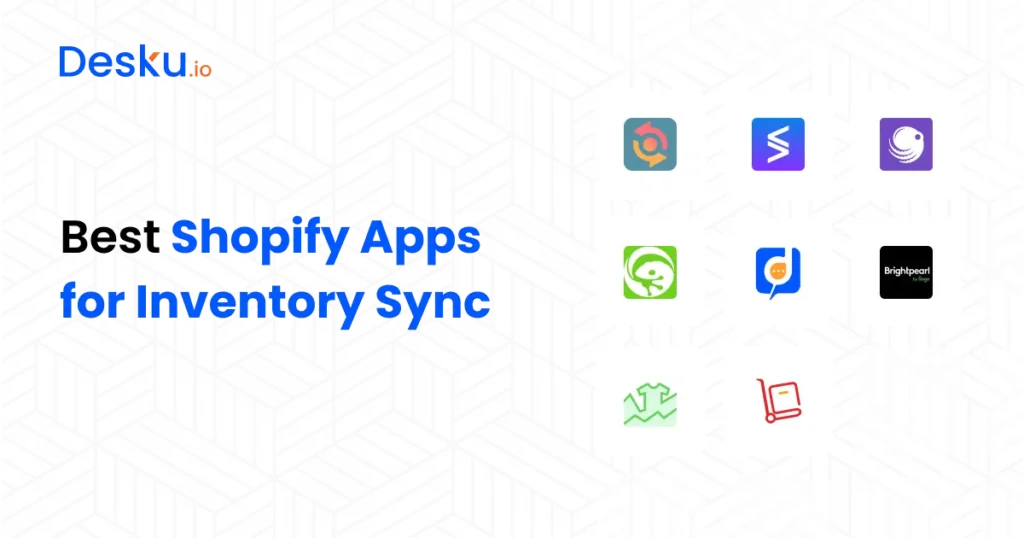Inventory management can be a headache for eCommerce store owners. The more sales channels you have, the more complicated it gets. Overselling, stockouts, and manual updates are just a few of the issues that can pop up. That’s why having a solid inventory sync app integrated with your Shopify store is crucial.
So, what’s the best Shopify inventory sync app? If you’re in a hurry, here’s a quick answer: [Top Pick App Name]. It’s highly rated for its ease of use, real-time sync, and multi-channel support. But there’s more to the story.
In this article, we’ll dive into nine of the best inventory sync apps that work with Shopify. We’ll cover the key features, pros and cons, pricing, and which apps are best suited for different business needs. Whether you’re a small business just getting started or a large operation needing advanced features, this guide will help you make the right choice.
Shopify’s revenue increased by 24% in Q4 2023, reaching $2.14 billion. (source)
Why You Need a Shopify Inventory Sync App
Running an eCommerce store comes with its fair share of challenges, and keeping your inventory in check is one of the big ones. Imagine a scenario where you’re selling on multiple platforms—Shopify, Amazon, eBay—maybe even a physical store. Every sale on one platform needs to reflect across all others. If it doesn’t, you risk overselling or having stockouts, both of which can frustrate customers and harm your brand’s reputation.
This is where Shopify inventory sync apps come into play. They ensure your inventory levels are updated in real-time across all your sales channels. With the right app, you can automate inventory management, reduce human error, and focus on growing your business.
Here’s why having an inventory sync app is a game-changer:
- Real-Time Updates: No more manually updating stock levels. These apps sync your inventory in real-time across all platforms, preventing issues like overselling.
- Multi-Channel Selling: Selling on multiple platforms is easier when your inventory is synced across all channels, ensuring consistent stock levels everywhere.
- Time-Saving Automation: By automating inventory management, you can focus on other aspects of your business, knowing your stock levels are always accurate.
- Reduced Human Error: Manual updates can lead to mistakes. With an inventory sync app, the process is automated, minimizing the chance of errors.
Investing in a good Shopify inventory sync app can help you avoid common inventory pitfalls and keep your business running smoothly, no matter how many channels you’re selling on.
Top 07 Shopify Inventory Sync Apps
Managing inventory across multiple sales channels is a crucial task for any eCommerce business. The right inventory sync app can automate this process, saving you time and reducing errors. Below are the top 09 Shopify inventory sync apps that can help you keep your stock levels in check, no matter how complex your operations.
1. Syncio

Syncio is designed for businesses that manage inventory across multiple Shopify stores. It allows you to sync products and inventory in real-time, making it easier to handle multiple storefronts without worrying about stock discrepancies.
- Key Features:
- Real-time inventory sync across multiple Shopify stores.
- Bulk product syncing and updates.
- Integration with other Shopify apps for a seamless workflow.
- Easy setup with no coding required.
- Pros:
- Perfect for businesses with multiple Shopify stores.
- Simple and user-friendly interface.
- Reduces overselling by syncing in real-time.
- Cons:
- Limited to Shopify-to-Shopify syncing; doesn’t support other platforms.
- Pricier than some competitors.
- Pricing:
- Starts at $19/month per store.
- Rating:
- 4.7 out of 5 stars on Shopify App Store.
- User Review Overview:
- Users praise Syncio for its ease of use and reliable performance. Some have noted that while it’s a bit pricey, the time saved on inventory management makes it worth the investment.
2. Stock Sync
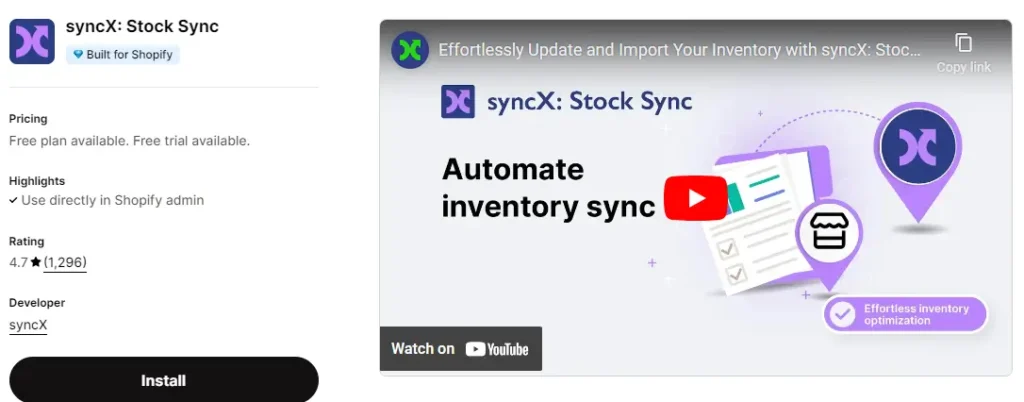
Stock Sync is a versatile app that offers various methods to update inventory, including via CSV files, FTP, email, and more. It’s ideal for businesses that need a flexible inventory management solution that works with multiple platforms.
- Key Features:
- Supports over 30 types of inventory feeds.
- Automated inventory updates through multiple channels.
- Real-time sync with various platforms, not just Shopify.
- Customizable rules for handling out-of-stock products.
- Pros:
- Highly flexible with numerous syncing methods.
- Supports multi-channel inventory management.
- Affordable pricing with a free plan available.
- Cons:
- The interface can be overwhelming for beginners.
- Limited support for certain types of inventory feeds.
- Pricing:
- Starts at $5/month with a free plan available.
- Rating:
- 4.8 out of 5 stars on Shopify App Store.
- User Review Overview:
- Users appreciate Stock Sync for its flexibility and affordability. Some beginners find the interface challenging at first, but overall, it’s highly rated for its powerful features.
3. Sellbrite
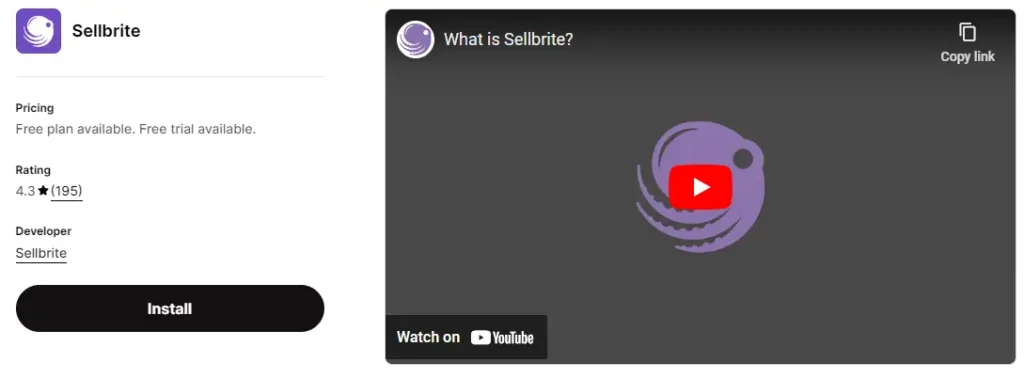
Sellbrite is a powerful multi-channel inventory management tool that helps you sync inventory across various platforms like Shopify, Amazon, eBay, and more. It’s a great solution for businesses looking to streamline operations across multiple sales channels.
- Key Features:
- Multi-channel inventory sync with platforms like Amazon, eBay, Walmart, and more.
- Centralized inventory management dashboard.
- Order routing to the appropriate fulfillment center.
- Built-in listing tool for adding products to multiple channels at once.
- Pros:
- Excellent multi-channel support.
- Centralized management makes it easy to track inventory across platforms.
- Includes order management features.
- Cons:
- Higher pricing compared to single-channel apps.
- Some users report a learning curve with advanced features.
- Pricing:
- Starts at $29/month with a 14-day free trial.
- Rating:
- 4.6 out of 5 stars on Shopify App Store.
- User Review Overview:
- Sellbrite receives high marks for its comprehensive multi-channel support. Some users note that the advanced features take time to master, but overall, it’s praised for streamlining inventory and order management across different platforms.
4. TradeGecko (now QuickBooks Commerce)
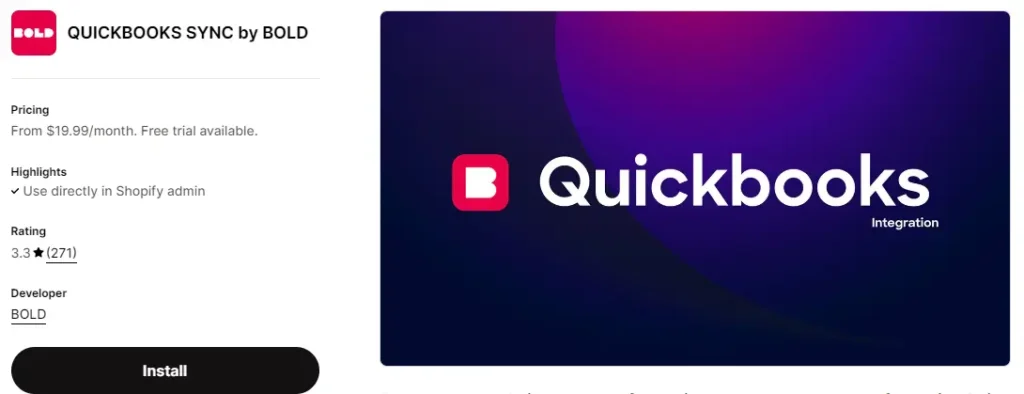
TradeGecko, recently rebranded as QuickBooks Commerce, is an inventory management tool designed for growing businesses. It offers advanced inventory features and integrates seamlessly with QuickBooks for accounting.
- Key Features:
- Real-time inventory and order management.
- B2B eCommerce platform integration.
- Automatic reordering based on stock levels.
- Detailed reporting and analytics.
- Pros:
- Integrates well with QuickBooks for accounting.
- Supports both B2B and B2C operations.
- Comprehensive inventory management features.
- Cons:
- Higher cost compared to other apps.
- Some users report occasional syncing issues.
- Pricing:
- Starts at $39/month, with higher-tier plans available.
- Rating:
- 4.5 out of 5 stars on Shopify App Store.
- User Review Overview:
- Users like the robust features and QuickBooks integration, but some mention the price as a downside. Overall, it’s well-regarded for businesses needing advanced inventory management.
5. Brightpearl
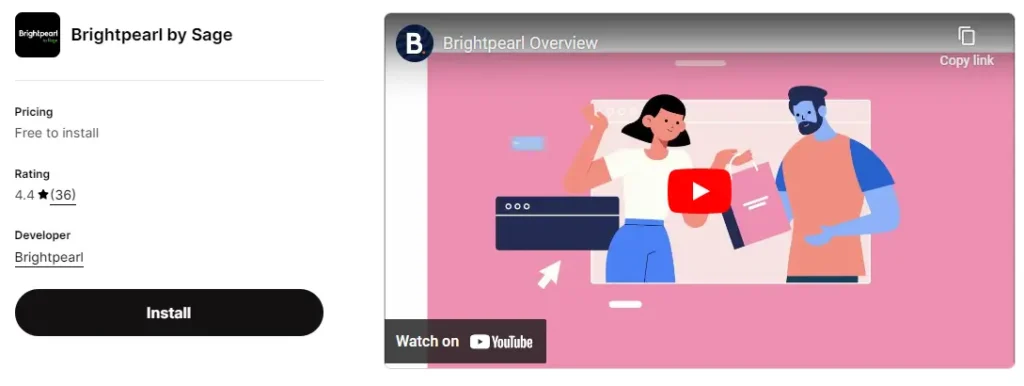
Brightpearl is a retail management system that combines inventory management, order management, and accounting into one platform. It’s designed for businesses that want an all-in-one solution to manage their operations.
- Key Features:
- Real-time inventory management with multi-channel support.
- Integrated accounting and order management.
- Automation tools for repetitive tasks.
- Detailed reporting and analytics.
- Pros:
- All-in-one solution for retail management.
- Strong multi-channel support with real-time syncing.
- Integrated accounting features.
- Cons:
- Expensive compared to other inventory apps.
- Not ideal for small businesses with simple needs.
- Pricing:
- Custom pricing based on business size and needs, starting around $300/month.
- Rating:
- 4.2 out of 5 stars on Shopify App Store.
- User Review Overview:
- Brightpearl is highly rated for its comprehensive features, especially by businesses that need an all-in-one solution. However, the cost and complexity may be overkill for smaller operations.
6. Inventory Planner
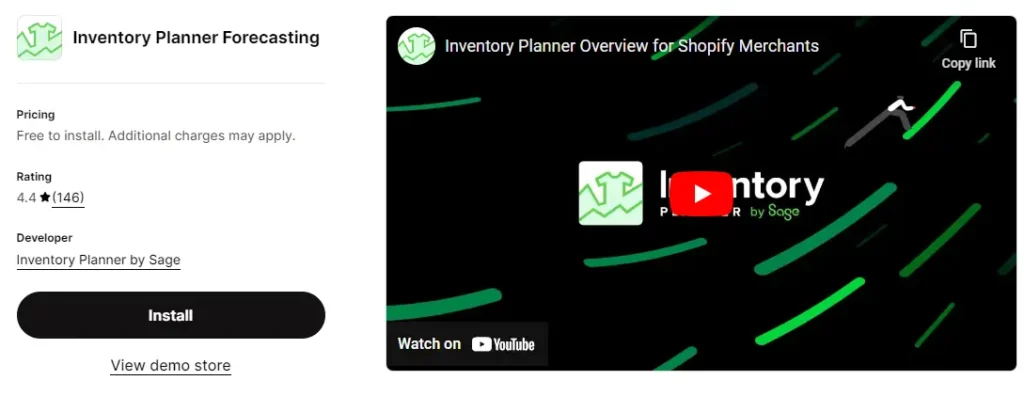
Inventory Planner is focused on helping businesses optimize their stock levels by providing smart forecasting and planning tools. It’s great for businesses that want to reduce overstock and prevent stockouts.
- Key Features:
- Inventory forecasting and planning.
- Automated purchase orders based on sales data.
- Multi-location inventory management.
- Integration with various eCommerce platforms.
- Pros:
- Excellent forecasting and planning features.
- Helps reduce overstock and stockouts.
- Easy-to-use interface.
- Cons:
- Limited to inventory planning and forecasting, not full inventory management.
- Higher cost for advanced features.
- Pricing:
- Starts at $99/month with a 14-day free trial.
- Rating:
- 4.5 out of 5 stars on Shopify App Store.
- User Review Overview:
- Users love Inventory Planner for its powerful forecasting tools, which help them manage stock levels more effectively. However, some users wish it offered more comprehensive inventory management features.
7. Zoho Inventory

Zoho Inventory is part of the larger Zoho suite of business tools. It’s designed for small to medium-sized businesses that need an affordable, yet powerful inventory management solution.
- Key Features:
- Multi-channel inventory management.
- Integrated with Zoho’s suite of business tools.
- Automated order and inventory updates.
- Supports multiple warehouses and dropshipping.
- Pros:
- Affordable pricing with strong features.
- Integrates well with other Zoho tools like CRM and accounting.
- User-friendly interface.
- Cons:
- Some features locked behind higher-tier plans.
- Limited third-party integrations compared to other apps.
- Pricing:
- Starts at $39/month with a free plan available.
- Rating:
- 4.4 out of 5 stars on Shopify App Store.
- User Review Overview:
- Zoho Inventory is appreciated for its integration with the broader Zoho ecosystem and its affordability. Some users wish for more third-party integrations, but overall, it’s a strong option for small to medium-sized businesses.
Criteria for Choosing the Best Inventory Sync Apps
Not all inventory sync apps are created equal. When choosing the right one for your Shopify store, there are several factors you need to consider. Here’s a quick rundown of what to look for:
Real-Time Syncing
The main purpose of an inventory sync app is to keep your stock levels updated in real-time. Make sure the app you choose can handle real-time syncing across all your sales channels.
Ease of Use
You don’t want to spend hours trying to figure out how to use the app. Look for an app with an intuitive interface and easy setup process.
Pricing
Depending on the size of your business, budget can be a significant factor. Some apps offer free versions with limited features, while others are premium with all the bells and whistles. Choose an app that fits your budget without compromising on essential features.
Integration Capabilities
Your chosen app should easily integrate with Shopify and other platforms you’re using, such as Amazon, eBay, or your POS system.
Customer Support
When things go wrong (and they sometimes do), responsive customer support can be a lifesaver. Check if the app offers 24/7 support and what users say about their support experience.
Scalability
As your business grows, your needs will evolve. Choose an app that can scale with you, offering additional features or higher-tier plans as your business expands.
How to Set Up and Optimize Inventory Sync on Shopify
Once you’ve chosen the right inventory sync app for your Shopify store, the next step is to set it up and ensure it’s working efficiently. Here’s a step-by-step guide to help you get started and optimize your inventory syncing process.
1. Install Your Chosen Inventory Sync App
- Go to the Shopify App Store: Search for your chosen inventory sync app.
- Click “Add App”: Follow the on-screen instructions to install the app on your Shopify store.
- Authorize Permissions: The app will likely need access to your product data, orders, and other settings. Authorize these permissions to enable full functionality.
2. Connect Your Sales Channels
Most inventory sync apps allow you to connect multiple sales channels, including marketplaces like Amazon, eBay, and other eCommerce platforms.
- Add Your Sales Channels: In the app’s dashboard, look for an option to connect or integrate with other sales channels.
- Follow Setup Instructions: Each platform might require specific steps to connect, such as API keys or login credentials. Follow the instructions provided by the app.
- Test the Connection: Once connected, verify that the channels are communicating correctly with your Shopify store.
3. Configure Inventory Rules
Setting up the right rules is crucial for effective inventory management. Depending on the app, you can configure various settings to control how inventory is synced.
- Sync Frequency: Choose how often the app updates inventory levels (e.g., real-time, hourly, daily).
- Out-of-Stock Handling: Decide how the app should handle out-of-stock products. For instance, you might want to hide products from your storefront when they’re out of stock or mark them as unavailable.
- Channel Prioritization: If you sell on multiple channels, set rules to prioritize which channel updates first. This is useful for avoiding conflicts if stock levels differ across platforms.
4. Test Your Setup
Before fully relying on your new inventory sync setup, it’s crucial to test it to ensure everything is working as expected.
- Perform Test Orders: Place a few test orders on different sales channels to see how the inventory updates across platforms.
- Check Inventory Levels: After the test orders, verify that inventory levels are correctly updated on Shopify and other connected channels.
- Monitor for Errors: Keep an eye on the app’s dashboard for any error messages or syncing issues during the test phase.
5. Optimize for Performance
After setting up and testing your inventory sync app, you can optimize its performance for better efficiency.
- Enable Alerts/Notifications: Set up alerts or notifications for low stock levels, sync errors, or discrepancies. This helps you react quickly to potential issues.
- Regular Audits: Periodically audit your inventory to ensure the sync process is functioning correctly. Look out for any inconsistencies in stock levels across your channels.
- Adjust Sync Rules as Needed: As your business grows or changes, you might need to adjust your sync rules. For instance, you may need to update how often your inventory syncs or which channels get priority.
key features to look in shopify inventory sync apps
When selecting a Shopify inventory sync app, it’s important to consider features that align with your business needs. Here are the key features you should look for:
1. Real-Time Inventory Syncing
- Why It Matters: Real-time syncing ensures that your inventory levels are updated instantly across all connected sales channels. This helps prevent overselling or stockouts, which can lead to unhappy customers and lost sales.
- What to Look For: The app should automatically update inventory levels as soon as a sale is made or stock is adjusted.
2. Multi-Channel Support
- Why It Matters: If you sell on multiple platforms (e.g., Amazon, eBay, physical stores), you need an app that can sync inventory across all these channels seamlessly.
- What to Look For: Ensure the app supports the specific platforms you sell on, including marketplaces, POS systems, and other eCommerce platforms besides Shopify.
3. Easy Integration
- Why It Matters: The app should integrate smoothly with Shopify and any other platforms or tools you use, like accounting software or order management systems.
- What to Look For: Look for apps that offer one-click integrations or have robust API support for custom setups.
4. Automated Inventory Rules
- Why It Matters: Automating inventory rules can save time and reduce errors by automatically adjusting stock levels, setting reorder points, or managing out-of-stock products.
- What to Look For: The app should allow you to set up custom rules for managing inventory, such as automatic reordering, stock thresholds, or channel-specific inventory adjustments.
5. Bulk Product Management
- Why It Matters: Managing inventory in bulk is essential if you have a large catalog. This feature allows you to update inventory levels for multiple products at once, saving time and reducing manual work.
- What to Look For: Check if the app supports bulk actions like importing inventory data via CSV files or applying changes to multiple SKUs simultaneously.
6. Multi-Location Inventory Management
- Why It Matters: If you operate out of multiple warehouses or physical stores, you need an app that can manage inventory across different locations efficiently.
- What to Look For: The app should offer features like location-specific inventory tracking, transfer between locations, and reporting for each location.
7. Order Management Integration
- Why It Matters: Seamless integration between inventory sync and order management ensures that your stock levels are always accurate after an order is placed.
- What to Look For: The app should update inventory levels automatically when an order is fulfilled, canceled, or returned, across all channels.
8. Reporting and Analytics
- Why It Matters: Access to detailed reports and analytics can help you make informed decisions about stock levels, sales trends, and inventory performance.
- What to Look For: The app should provide reports on inventory levels, stock movement, sales trends, and forecasts to help you optimize your inventory management.
FAQs
1. What’s the best free Shopify inventory sync app?
If you’re looking for a free option, Stock Sync offers a free plan that’s perfect for small businesses. It includes basic inventory syncing features and is easy to set up, making it an ideal choice if you’re just starting out or on a tight budget.
How do I handle multi-channel inventory syncing?
To manage multi-channel inventory syncing effectively, use an app like Sellbrite or Skubana. These apps support multiple platforms and allow you to set up rules to prioritize how inventory is synced across channels. Make sure all your platforms are connected and set the sync frequency to real-time to avoid any discrepancies.
Can these apps handle high-volume inventory updates?
Yes, apps like Skubana and Brightpearl are designed to handle high-volume inventory updates. They offer robust features and scalability for larger operations, ensuring your inventory levels stay accurate even during peak sales periods.
What happens if an app fails to sync inventory?
If an app fails to sync inventory, most of them will notify you via alerts or error messages. It’s important to regularly check the app’s dashboard for any syncing issues. Additionally, having a backup plan, such as manual syncing or contacting customer support, can help resolve the problem quickly.
How can I prevent overselling due to inventory sync delays?
To prevent overselling, choose an app that offers real-time syncing, like Syncio or Sellbrite. You can also set buffer stock levels—keeping a small quantity unlisted to ensure you never accidentally oversell due to a sync delay.
Are there apps that specialize in syncing inventory for dropshipping?
Yes, Ecomdash and Inventory Planner are great choices for dropshipping businesses. These apps support automated inventory updates and order fulfillment, making it easier to manage stock levels across multiple dropshipping suppliers.
Conclusion
Managing inventory can be one of the most challenging aspects of running an eCommerce business, especially when you’re selling on multiple platforms. The right Shopify inventory sync app can make this process seamless, saving you time, reducing errors, and ultimately helping you provide a better customer experience.
From versatile apps like Stock Sync to enterprise-level solutions like Skubana, there’s an inventory sync app for every type of business. Whether you’re a small store just getting started or a large operation with complex needs, the tools listed here can help you keep your inventory in check.
When choosing an app, consider your specific needs—whether it’s real-time syncing, multi-channel support, or ease of use. And remember, it’s always a good idea to test an app before fully integrating it into your operations to ensure it meets your expectations.
By investing in the right inventory sync app, you can streamline your operations, minimize costly errors, and focus more on growing your business rather than managing your stock levels.
